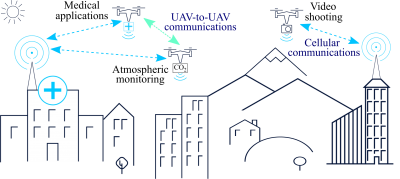Giovanni Geraci, Universitat Pompeu Fabra, Spain, Adrian Garcia-Rodriguez, Nokia Bell Labs, Ireland, and Xingqin Lin, Ericsson Research, USA
Published: 4 Jun 2019

CTN Issue: June 2019
A note from the editor:
For most of its short history, the wireless playground has been essentially two-dimensional. Indeed, most of the models invoked to research and design existing wireless networks are defined on a plane, with the role of elevation being minimal, even anecdotal. This started to shift in recent years, with the vertical dimension acquiring importance in urban centers as the progressive network densification rendered the cell sizes comparable to the height of high-rise buildings and structures. Now, the relevance of the vertical dimension is about to explode, as a new class of wireless users makes its appearance in the landscape of wireless communications: drones. The notions and ideas that have henceforth shaped the evolution of wireless networks will have to be augmented with aspects muted to date, such as vertical antenna patterns, and with fresh concepts related to drone trajectories, altitudes, and capabilities. All of this, and more, is discussed in this month’s article by three first-rate experts on the matter. Enjoy.
Angel Lozano
Editor
Preparing the Ground for Drone Communications



The Cradle
The more romantic of us will always prefer the relaxing chirping of birds to the loud spinning rotors of a drone. Nonetheless, even avid nature lovers agree on the benefits of automating weather monitoring, search-and-rescue operations, and filming of breathtaking mountain settings. Indeed, these and many more tasks could be made cheaper, faster, and more efficient by employing a workforce of network-connected unmanned aerial vehicles (UAVs), a.k.a., drones.
The new revenue opportunities stemming from a proliferation of drones have been luring mobile network operators and vendors, which gathered at 3GPP meetings with the aim of integrating drones in existing—or soon-to-be-deployed—terrestrial networks and collaborated on providing an enhanced cellular support for aerial vehicles. Such joint effort produced systematic measurements and an accurate height-dependent channel model, and also defined various drone link types and requirements [1].
Though spurred by different interests, academia and the telecommunications industry promptly agreed on the socio-economic benefits of cellular-connected drones, on the need for reliable command and control links and fast wireless connectivity, and on the technical hurdles—chiefly mobility and line-of-sight interference—to be overcome.
Unlike terrestrial users, usually served by the main lobe of a base station antenna pointing towards the ground, drones may fly in areas only covered by antenna sidelobes and, accordingly, associate to a far-flung base station [2] [3]. While a scattered cell association pattern is not necessarily a problem per se, aerial users served by a sidelobe might experience very sharp drops in signal strength during their flight. Moreover, flying above the clutter of buildings, drones are very sensitive to the line-of-sight signals received from a plurality of base stations. This strong inter-cell interference may result in a forward-link degradation, preventing drones from receiving the critical and time-sensitive command and control information. Conversely, in the reverse link, drones can generate strong line-of-sight interference to a multiplicity of cells, and may overwhelm the weaker signals received from ground users. The uplink rates of the latter may thus plummet as the number of drones increases.
The opportunities and challenges to be found up in the sky soon shifted the paradigm from “what drones could do for us” to “what networks could do for drones”.

The Hype!
As a result, while drone communications are still far from impacting anybody’s daily routine, they have been holding sway in our research community. A quick check on the numbers of related tutorials offered at the two ComSoc flagship events reveals an impressive growth: one at Globecom’16, two at Globecom’18, and four at ICC’19! Similar conclusions could be drawn from the number of published papers per year on IEEE Xplore, which more than doubled between 2016 and 2018, and from the amount of funding granted to keep fueling UAV-focused research.
The Crawl...
Was it quantity over quality? The first batch of academic research on drone communications arguably struggled to step out of its comfort zone. Possibly, the pursuit of analytical tractability prevented simultaneously accounting for rigorous propagation models, embracing credible use cases and operating assumptions, and providing a complete system-level view. In other words, we witnessed a disconnect between what was being discussed at standards meetings and technical conferences. The former was driven by a race for technology leadership and practical needs in the mobile industry, the latter by a quest for general and elegant theoretical results.
The limited feedback, or lack thereof, between academia and industry was just the tip of the iceberg. UAV-related regulations did not advance as fast as some UAV visionaries hoped. Many countries kept mandating visual-line-of-sight control of drones (unless a waiver of the operational restriction is granted), making free remote piloting not much more than wishful thinking [4]. A combination of technical and logistical challenges slowed down ambitious industrial projects, such as Facebook’s one of providing internet coverage to remote areas through solar-powered drones [5]. The 3GPP, currently working on Release 16 due in June 2020, decided to push most of the UAV-related items to Release 17 [6].
All in all, the community started to accept that forward-looking dreams of seeing swift drones reliably transporting human organs across the city for a transplant might take longer than expected to come true.
Crash or Take-Off?
Is drone communications research fading? Quite the opposite. Leveraging the opportunity that lies in every impasse, academia and industry have reconciled and strengthened their interplay through mutual awareness first, joint research next. More recent publications have lowered the level of abstraction compared to their pioneering counterparts, accounting for real-world propagation channel features [7-9], the impact of mobility on the performance of cellular-connected drones [10], and the role of wireless fronthaul when drones act as relaying base stations [11].
And it is not just about papers. Leading companies like Google, Microsoft, and Uber keep exploring the viability of employing drones for aircraft inspection or mosquito tracking [12]. Meanwhile, 3GPP is working on identifying requirements and key performance indicators for these new applications [13]. Illustrative examples among the big vendors include Nokia’s F-Cell project for self-powered, self-configured, and auto-connected drone small cells [14], Huawei’s Digital Sky Initiative for an end-to-end ecosystem for drone-related trials in Shanghai [15], and Ericsson’s work in the relevant forums to align mobile network capabilities with drone communication and traffic management requirements [16].
Sure enough, it is an auspicious time to dive into this exciting field of research, still at its dawn. As the list of communication-related challenges keeps growing alongside that of drone use cases, our community cannot be anything but excited for the upcoming fly-and-connect era.
References
- S. D. Muruganathan, X. Lin, H.-L. Maattanen, Z. Zou, W. A. Hapsari, and S. Yasukawa, “An Overview of 3GPP Release-15 Study on Enhanced LTE Support for Connected Drones,” [Online]. Available: https://arxiv.org/abs/1805.00826.
- G. Geraci, A. Garcia-Rodriguez, L. Galati Giordano, D. López-Pérez and E. Björnson, "Understanding UAV Cellular Communications: From Existing Networks to Massive MIMO," in IEEE Access, vol. 6, pp. 67853-67865, Nov. 2018.
- X. Lin, V. Yajnanarayana, S. D. Muruganathan, S. Gao, H. Asplund, H.-L. Maattanen, M. Bergstrom, S. Euler and Y.-P. Wang, "The Sky Is Not the Limit: LTE for Unmanned Aerial Vehicles," in IEEE Commun. Mag., vol. 56, no. 4, pp. 204-210, Apr. 2018.
- A. Fotouhi, H. Qiang, M. Ding, M. Hassan, L. Galati-Giordano, A. Garcia-Rodriguez, and J. Yuan, “Survey on UAV cellular communications: Practical aspects, standardization advancements, regulation, and security challenges,” in IEEE Commun. Surveys Tuts., vol. PP, 2019.
- https://spectrum.ieee.org/tech-talk/telecom/internet/facebook-pulls-out-of-secret-spaceport-internet-drone-tests.
- https://www.3gpp.org/DynaReport/GanttChart-Level-2.htm.
- A. Garcia-Rodriguez, G. Geraci, D. López-Pérez, L. Galati Giordano, M. Ding, and E. Björnson. ‘‘The essential guide to realizing 5G-connected UAVs with massive MIMO,’’ [Online]. Available: https://arxiv.org/abs/1805.05654.
- http://ma-mimo.ellintech.se/2018/09/21/uavs-prepare-for-take-off-with-massive-mimo/.
- Y. Zeng, Q. Wu, and R. Zhang, “Accessing from the sky: A tutorial on UAV communications for 5G and beyond,” [Online]. Available: https://arxiv.org/abs/1903.05289
- S. Euler, H.-L. Maattanen, X. Lin, Z. Zou, M. Bergström, and J. Sedin, “Mobility support for cellular connected unmanned aerial vehicles: Performance and analysis,” [Online]. Available: https://arxiv.org/abs/1804.04523.
- B. Galkin, J. Kibilda, and L. A. DaSilva, "Backhaul for Low-Altitude UAVs in Urban Environments," in Proc. IEEE Int. Conf. on Commun. (ICC), Kansas City, MO, 2018, pp. 1-6.
- https://www.theguardian.com/technology/2018/may/10/apple-microsoft-uber-drones-approved-testing-amazon.
- 3GPP Technical Report 22.829, “Technical Specification Group Services and System Aspects; Study on Enhancement for Unmanned Aerial Vehicles (Release 17),” Mar. 2019.
- https://www.nokia.com/about-us/news/releases/2016/10/03/f-cell-technology-from-nokia-bell-labs-revolutionizes-small-cell-deployment-by-cutting-wires-costs-and-time/.
- https://www.huawei.com/en/industry-insights/outlook/mobile-broadband/xlabs/industry-views/digital-sky-initiative.
- Ericsson white paper, “Drones and networks: Ensuring safe and secure operations,” [Online]. Available: https://www.ericsson.com/assets/local/publications/white-papers/10201110_wp_dronesandmobilenetworks_nov18.pdf
Statements and opinions given in a work published by the IEEE or the IEEE Communications Society are the expressions of the author(s). Responsibility for the content of published articles rests upon the authors(s), not IEEE nor the IEEE Communications Society.


